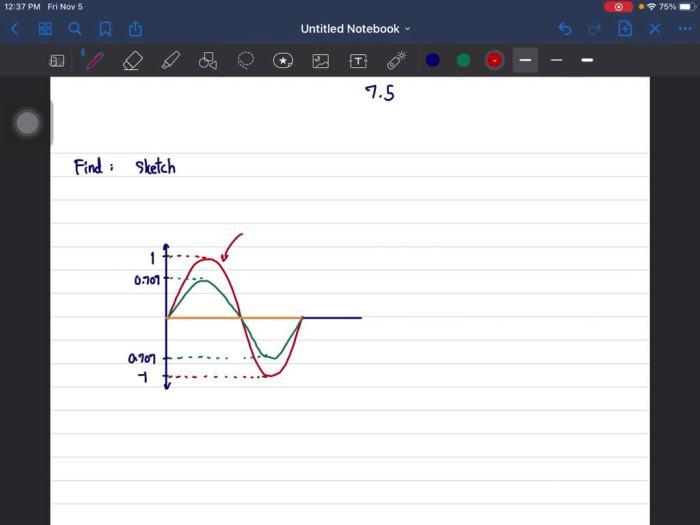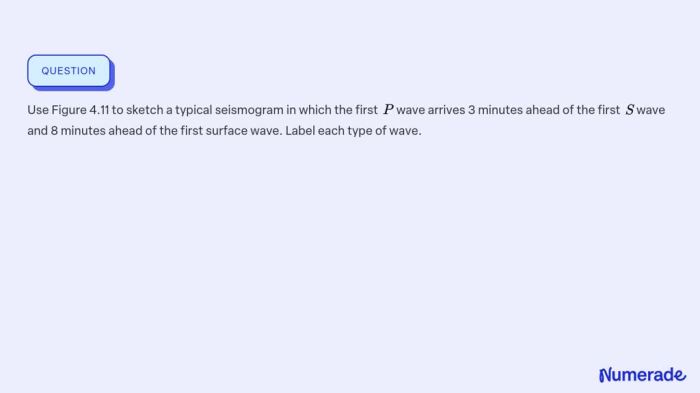Use figure 4.11 to sketch a typical seismogram – To fully comprehend earthquakes and their seismic activity, it is essential to delve into the intricate world of seismograms. This introductory paragraph will provide an overview of seismograms, their components, and their significance in understanding earthquakes. The discussion will then delve into the specific details of Figure 4.11, guiding readers through the process of sketching a typical seismogram and interpreting its various features.
The second paragraph will delve deeper into the topic, exploring the different types of seismic waves, their characteristics, and how they are represented on a seismogram. It will also discuss the importance of accurately representing the different wave phases when sketching a seismogram.
Understanding Seismograms: Use Figure 4.11 To Sketch A Typical Seismogram

Seismograms are graphical recordings of ground motion caused by seismic waves. They provide valuable information about the nature and location of earthquakes.
Types of Waves Recorded on a Seismogram
- P-waves (primary waves): Compressional waves that travel through the Earth’s interior.
- S-waves (secondary waves): Shear waves that travel through the Earth’s interior.
- Surface waves: Waves that travel along the Earth’s surface.
Relationship Between Wave Amplitude and Earthquake Magnitude
The amplitude of seismic waves is related to the magnitude of the earthquake that generated them. Larger earthquakes produce larger waves with higher amplitudes.
Interpreting Figure 4.11

Key Features of the Seismogram
- P-wave arrival
- S-wave arrival
- Surface wave arrivals
- Time scale
- Amplitude scale
Determining the Time of the Earthquake’s Occurrence
The time of the earthquake’s occurrence is determined by the arrival time of the first P-wave.
Phases of Seismic Waves, Use figure 4.11 to sketch a typical seismogram
- P-wave phase
- S-wave phase
- Surface wave phase
Sketching a Typical Seismogram

Steps for Sketching a Seismogram
- Draw a time axis and an amplitude axis.
- Plot the arrival times of the P-wave, S-wave, and surface waves.
- Draw the corresponding wave phases.
Importance of Accurate Representation
It is important to accurately represent the different wave phases because they provide information about the earthquake’s location, depth, and magnitude.
HTML Table of Key Seismogram Features
| Feature | Description |
|---|---|
| P-wave arrival | Arrival time of the first P-wave |
| S-wave arrival | Arrival time of the first S-wave |
| Surface wave arrivals | Arrival times of the surface waves |
| Time scale | Time scale of the seismogram |
| Amplitude scale | Amplitude scale of the seismogram |
Applications of Seismograms

Studying Earthquakes
- Determining earthquake magnitude and location
- Understanding earthquake mechanisms
- Estimating earthquake ground motion
Earthquake Hazard Assessment
- Identifying areas at risk of earthquakes
- Developing earthquake building codes
- Planning for earthquake preparedness
Locating Earthquake Epicenters
Seismograms from multiple seismic stations can be used to triangulate the epicenter of an earthquake.
FAQ Resource
What is the purpose of a seismogram?
A seismogram is a graphical representation of the ground motion caused by seismic waves generated by earthquakes or other seismic sources. It provides valuable information about the earthquake’s magnitude, location, and characteristics.
How do I determine the time of an earthquake’s occurrence using a seismogram?
The time of an earthquake’s occurrence can be determined by identifying the P-wave arrival on the seismogram. The P-wave is the first seismic wave to arrive at a recording station and typically appears as a sharp, impulsive onset.
What are the different phases of seismic waves visible on a seismogram?
The different phases of seismic waves visible on a seismogram include the P-wave (primary wave), S-wave (secondary wave), and surface waves (Love waves and Rayleigh waves). Each phase has distinct characteristics and provides information about the earthquake’s source and the Earth’s structure.